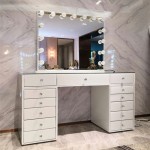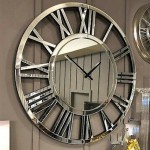Do You Need To Secure A Floor Mirror On The Walls?
Floor mirrors are a popular addition to many homes, serving both a functional purpose and enhancing interior design. They can create the illusion of more space, brighten a room by reflecting light, and provide a full-length view for dressing. However, the question of whether or not to secure a floor mirror to the wall is a crucial one that warrants careful consideration. The decision is influenced by various factors, including safety, stability, traffic within the room, and personal preferences. Weighing these elements will help determine the best course of action for any given situation involving a full-length freestanding mirror.
Leaving a floor mirror unsecured might seem like a simple convenience, allowing for easy relocation and adjustment within a room. However, this convenience comes with potential risks. Understanding these risks and the potential benefits of securing the mirror are essential for making an informed decision that prioritizes safety and longevity. The following points will delve into the various aspects of this decision-making process, providing a comprehensive overview of the factors involved.
Safety Considerations: Preventing Accidents and Injuries
The most compelling argument for securing a floor mirror to the wall revolves around safety. Unsecured mirrors, especially larger ones, pose a significant risk of tipping over. This risk is amplified in households with children or pets, who may inadvertently bump into the mirror, causing it to fall and potentially result in serious injury. The weight of the glass and frame can cause significant harm, particularly to young children.
Even in homes without children or pets, accidental bumps can occur. Moving furniture, cleaning, or simply walking too close to an unsecured mirror can lead to it tipping over. The consequences extend beyond potential physical harm. A falling mirror can damage flooring, walls, and other nearby objects, leading to costly repairs. Therefore, prioritizing safety by securing the mirror is a proactive measure to prevent accidents and protect both individuals and property from potential harm.
The likelihood of a tip-over incident also depends on the design of the mirror itself. Mirrors with a narrow base or a top-heavy design are inherently more unstable and more prone to falling. These types of mirrors require extra vigilance and are often best secured, regardless of other factors. Consideration should also be given to the floor surface on which the mirror stands. Carpeting can offer some resistance, while smooth surfaces such as hardwood or tile increase the risk of the mirror sliding or tipping.
Securing a floor mirror is not merely a suggestion, but a preventative measure that mitigates a tangible risk. It transforms a potentially hazardous object into a stable and safe fixture, offering greater peace of mind and reducing the likelihood of accidents and injuries.
Stability and Longevity: Protecting Your Investment
Beyond the immediate safety concerns, securing a floor mirror contributes significantly to its stability and longevity. Constant wobbling or minor shifts in position, even if not resulting in a full tip-over, can gradually weaken the frame and joints of the mirror. Over time, this can lead to structural damage, reducing the lifespan of the mirror and possibly necessitating repairs or replacement.
When a floor mirror is firmly secured to the wall, it is less susceptible to vibrations caused by everyday activities such as walking, closing doors, or even nearby traffic. This stability reduces stress on the mirror's components and helps maintain its structural integrity over the long term. It also prevents the unsightly and potentially damaging occurrence of the mirror shifting out of alignment or rubbing against the wall, which can lead to scratches and abrasions on both surfaces.
Maintaining the stability of a floor mirror also enhances its functionality. A wobbly mirror can distort reflections and make it difficult to get an accurate view. Securing the mirror eliminates this distortion, providing a clearer and more reliable reflection. This is particularly important for individuals who rely on the mirror for dressing and grooming.
Investing in the proper hardware and taking the time to secure a floor mirror is an investment in its long-term stability and longevity. It is a simple and cost-effective way to protect a valuable item and ensure that it continues to provide both functional and aesthetic benefits for years to come.
Aesthetic and Practical Considerations: Balancing Design with Functionality
While safety and stability are paramount, aesthetic and practical considerations also play a role in the decision of whether or not to secure a floor mirror. Some homeowners might prefer the freedom to easily move the mirror to different locations within the room or even to other rooms. Securing the mirror eliminates this flexibility, making it a more permanent fixture.
However, the aesthetic impact of securing a floor mirror can be minimal, especially with the use of discreet mounting hardware. In fact, a securely mounted mirror can often appear more polished and intentional than one that is simply leaning against the wall. Some may find that a leaning mirror looks unfinished or temporary, while a wall-mounted mirror projects a sense of permanence and sophistication. Furthermore, securing the mirror eliminates the visual clutter of having the base of the mirror resting directly on the floor.
From a practical standpoint, securing a floor mirror can free up floor space. While the mirror still occupies the same overall area, eliminating the need for it to lean against the wall can create a more open and airy feel in the room. This is particularly beneficial in smaller spaces where every inch of floor space counts. Additionally, securing the mirror can make it easier to clean around it, as there is no need to constantly move the mirror to sweep or vacuum behind it.
The decision to secure a floor mirror should take into account both aesthetic preferences and practical needs. While the freedom to move the mirror is a valid consideration, the potential benefits of increased stability, improved functionality, and a more polished appearance should also be weighed carefully. Often, the peace of mind that comes with knowing the mirror is securely mounted outweighs the perceived inconvenience of losing the option to easily reposition it.
The method of securing a floor mirror to the wall can vary depending on the mirror's design and weight, as well as the type of wall. Options range from simple leaning restraints that prevent the mirror from tipping too far forward to more robust mounting systems that firmly attach the mirror to the wall studs. Consulting with a professional installer is advisable, particularly for heavy mirrors or when dealing with walls that may require specialized hardware.
Regardless of the chosen method, it is essential to select high-quality hardware that is appropriate for the weight of the mirror and the type of wall. Using the wrong type of screws or anchors can compromise the security of the installation and potentially lead to the mirror falling. It is also crucial to follow the manufacturer's instructions carefully and to double-check that all connections are secure before releasing the mirror.
In summary, the decision of whether or not to secure a floor mirror to the wall is a multifaceted one that requires careful consideration of various factors. Safety concerns, stability requirements, and aesthetic preferences all play a role in determining the best course of action. By thoroughly evaluating these factors and taking appropriate steps to secure the mirror, homeowners can create a safer, more stable, and more aesthetically pleasing environment.

How To Hang A Heavy Floor Mirror On The Wall Crazy Wonderful

How To Secure A Leaning Mirror The Wall Diy Playbook

Your Guide To Secure A Full Length Floor Mirror Any Wall Mirrors Direct

How To Secure A Floor Mirror Storables

Securing Your Wall Leaning Mirror Arkivio

How To Anchor A Leaning Mirror The Wall Loving Here

How To Anchor A Leaning Mirror The Wall Loving Here

How To Secure A Heavy Leaning Floor Mirror The Wall Large

How To Hang A Heavy Floor Mirror On The Wall Crazy Wonderful

How To Secure A Leaning Mirror Love Our Real Life








